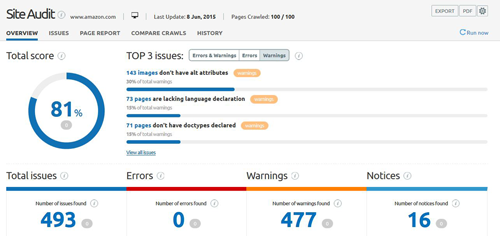6 Indicators of a Quality" Site for SEO"

Last month Google released an update initially referred to as the "Phantom Update," due to the fact that it was not acknowledged by Google for the first few weeks after its release.
It took some time but Google did confirm it updated how it assesses content quality - making it the perfect time for site owners, marketers and SEO professionals to evaluate their on-page SEO for these top six quality indicators.
What makes a "Quality" Site?
To summarize, a quality site is one that is built with the end-user in mind. It should avoid using tricks or sneaky tactics, and should provide a clear benefit or value to visitors. The core elements of a solid website are:
1. Content
Have valuable content that offers unique information or a unique perspective. You need to have information that other sites in your field do not have. If you do not have enough content to create an additional valuable page on your website, do not create one. If you are working on local SEO, you should also set up a consistent schedule for adding new content.
2. User Experience
If you have a website full of great text but it is jumbled into a single page without any visual aids, most people are not going to stick around and read it. Regardless of how you think Google collects data about on-page experience, I think we can all agree that if your website has high bounce rates and low engagement, your rankings are going to suffer as well.
3. Well-Maintained Site
Have you ever been to a site loaded with broken links and outdated information?
Most of you who have didn't stick around very long. Devote time on a regular basis to ensure that your website is properly functioning is more important than ever. While fixing broken links is a good start, you should also run a full scan of your site to identify and fix common on-page issues that could be costing you search traffic. SEMrush is one of my favorite tools for doing so, here is an example:

4. Intentional & Deceptive Tactics
Most of you already know but for those of you who may not, common tactics of years' past such as using scraped content, doorway pages, cloaking and a laundry list of other tactics will get your site into trouble quickly. When deciding what to do with your site refer to #2 above and you will be fine.
5. Website Security
One of the fastest ways for your website to be removed from the SERPs is by getting hacked. If your site is injected with Malware, it can be passed to the end-users and cause a chain of issues. Taking simple steps such as having a HTTPS site, using appropriate security protocol on your server, or even making sure you keep your CMS update regularly can reduce the likelihood of your site being infected.
6. Social Signals
While many will argue with this and Google has even mentioned it to be untrue, I can say with certainty that social signals are beneficial to a websites performance.
Social signals are not yet a stand-alone method of ranking a website, they are however both powerful and beneficial as part of the big picture. At the most basic level, social shares could lead to links for your site from others who are exposed to your content. At a higher level, it is a way to Google to attempt to understand how well received your content is by the end-user and to summarize what Google said a few years ago: our goal is not to make websites popular, it is to return popular websites. The bottom line, if you need another boost to get your site on page one, don't skip social signals - especially with Google once again indexing tweets in real-time.
Whether the information above was just a refresher for you or this is the first time you have stopped to consider these elements, I encourage you to take time today to review your website and see if your foundation is as solid as it could be.
Over to you...
What is one on-page change you have made and found to be beneficial? Are social signals part of your strategy? Tell us about it below!









